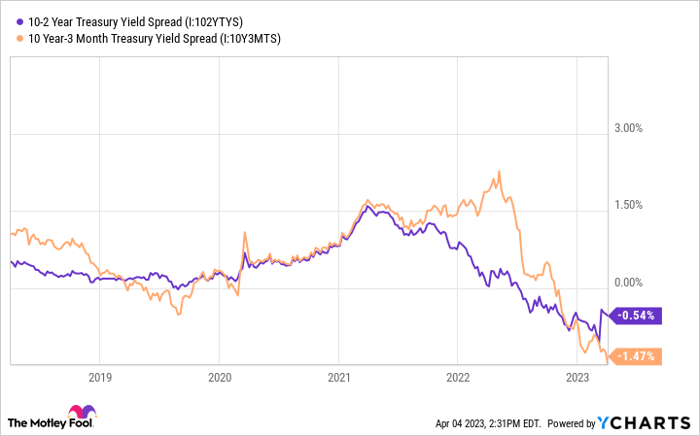If you’re not paying attention to the yield curve, then you’re probably missing important indicators for your retirement account’s performance. Last month, the yield curve sent out an ominous signal that’s likely to impact the stock and bond markets in the next few months. As important economic news hits the headlines, your retirement account is likely to react. Make sure that you’re ready to manage it through whatever comes next.
A brief primer on yield curves
The yield curve is a high-profile indicator for both the stock market and the economy. However, many investors don’t know how to interpret the metric, despite its importance. In short, the curve measures the difference between yields on similar bonds with different maturity dates, based on market prices for those bonds. The most commonly cited yield curve refers to U.S. Treasuries, comparing yields across maturities ranging from one month to up to 30 years.
A “steep” yield curve suggests that longer-duration bonds have higher rates than shorter-duration bonds. A flat curve suggests that there’s a relatively small difference across durations. An inverted yield curve is a somewhat rare situation in which shorter-duration bonds yield higher rates than their longer-term counterparts.

Image source: Getty Images.
In normal economic circumstances, bonds with longer durations generally have higher yields than bonds with shorter durations. This makes sense — people usually demand higher compensation to have their money tied up for longer periods. Longer time periods also open the door to more uncertainty and risk, which forces a bond issuer to pay a premium.
When these normal conditions break down, the yield curve for Treasuries often flattens or inverts. Curve inversion suggests that investors are perceiving abnormally high uncertainty and risk in the economy, and this has historically been a strong indicator of an upcoming recession. Of course, an indicator isn’t a guarantee, but it’s unwise to simply ignore a historically reliable signal from the bond market.
What is the yield curve indicating?
The yield curve flattened throughout 2021 and early 2022, then inverted last year. The chart below shows the difference between yields on 10-year Treasuries and shorter-duration bonds.
10-2 Year Treasury Yield Spread data by YCharts
In early March, the spread between two-year and 10-year Treasuries reached the widest level since the early 1980s, which many investors interpreted as a dire recession warning. That trend reversed sharply in the middle of March, bringing the two-year and 10-year yields closer together.
10-2 Year Treasury Yield Spread data by YCharts
It’s tempting to take this as a sign of recovery and a crisis averted, but history suggests that it could be the exact opposite. The yield curve’s latest shift more likely indicates that an economic downturn is imminent, prompting the Federal Reserve to halt its rate-hiking policy. The yield curve experienced a very similar shift in January 2007. A few months later, the financial system entered a serious crisis, we entered a global recession, and the Fed started slashing rates.
The March failure of several banks and turmoil in the financial sector fueled speculation that lending standards would tighten, pushing the economy closer to recession. Amid that disruption, the Fed announced that it would increase its target interest rate again in March, though its forward-looking commentary used softer language. These developments forced investors to revise their timeline for the economic cycle and monetary policy.
How to manage your retirement account
None of this news should trigger panic or overreaction, but it is a good time to make sure that you have your ducks in a row. The yield curve is indicating that adverse economic conditions lurk around the corner, and that’s likely to drive stock market volatility.
Make sure that your retirement portfolio allocation is in sync with your age and time to retirement. The closer you are to retirement, the more bond exposure you should have. Bonds typically don’t fluctuate in value as much as stocks, and they deliver returns in the form of interest even if their resale price is struggling.
Stocks help your retirement account grow throughout your working years, and it’s important to lock in those gains as you shift focus toward generating investment income. Don’t chase incremental gains shortly before retirement, leaving yourself at risk of a big market downturn from which your account never recovers. It’s also important to diversify duration within your bond portfolio. Having bonds mature at different intervals can nullify mayhem caused by economic factors and set your retirement account up to perform in any circumstance.
Upon review, you might discover that your retirement account allocation is already optimal. If you’re like many people who use target date funds in their 401(k), then there’s probably not much to do. If your retirement fund is properly diversified and aligned with your risk tolerance, then the best move is to remain calm and prepare yourself for temporary turbulence. Making unnecessary changes doesn’t actually help you. Things might be ugly for a few quarters — or even a few years — but you should expect things to recover in the longer term.
10 stocks we like better than Walmart
When our analyst team has an investing tip, it can pay to listen. After all, the newsletter they have run for over a decade, Motley Fool Stock Advisor, has tripled the market.*
They just revealed what they believe are the ten best stocks for investors to buy right now… and Walmart wasn’t one of them! That’s right — they think these 10 stocks are even better buys.
Stock Advisor returns as of March 8, 2023
The Motley Fool has a disclosure policy.








